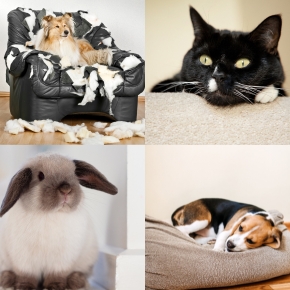
Is your pet bored?
According to our vets in Bayswater, when pets experience boredom, this can quickly lead to behavioural problems and a decline in overall wellbeing. To help you determine if your pet is bored, take our quick quiz below.
Before you dive in, it’s wise to remember that boredom symptoms can sometimes be confused with health problems. Contact us to book a check-up with our vets to be on the safe side.
Quiz: Is your pet bored?
1. Does your pet:
- Show signs of destructive behaviour? (e.g., chewing, digging, scratching, barking)
- Exhibit excessive grooming or licking?
- Become restless or anxious when left alone?
- Lose interest in activities they once enjoyed?
- Stay in bed more than usual?
2. Do you regularly:
- Provide your pet with new toys or puzzles, or rotate old ones?
- Engage in interactive play with your pet?
- Work on command or trick training with them?
- Take your pet dog on daily walks or outings?
If you answered “yes” to most of the first set of questions and “no” to most of the second set, your pet may be experiencing boredom. Remember to book a vet check-up at Bayswater Vets if your pet seems out of sorts – contact us to book.
Why is enrichment important for pets?
Bored pets can become frustrated and exhibit unwanted behaviours like excessive barking or chewing. Mental stimulation is key to keeping your pet engaged and happy. By providing enrichment activities, you can prevent boredom, encourage physical activity to maintain a healthy weight and mind, and strengthen your bond. This can lead to a healthier, happier, and more fulfilling life for your pet, and you.
To help your pet beat the boredom, our team at Bayswater Vets have created a handy list of Boredom Busting Ideas for you to try below.
Beat the boredom
Here are a few ways you can enrich your pet’s life:
- Refresh Toys: Provide new toys and interactive puzzles or rotate old ones to keep your pet interested.
- Interactive Play: Engage in interactive play time such as fetch or hide-and-seek.
- Obstacle Courses: Create indoor and outdoor (pet type dependant) obstacle courses using everyday materials like cushions, furniture, cardboard tubes, bamboo canes etc.
- Spice Up Mealtimes: Make mealtimes more fun with slow-feeder bowls, foraging trays, scatter feeding and snack search games.
- Training Time: Engage in regular short training sessions with your pet – brush up on their skills and teach them new ones.
- Engaging Environment: Create a stimulating environment appropriate to your pet’s species and needs; this could include hiding places, climbing opportunities, scratching posts, a mirror, or a secure window view.
- Explore Together: Take your pet on outings and explore new places and experiences together.
- Bonding Time: Create bonding opportunities with your pet, whether that’s stroking them whilst watching a movie or giving them a relaxing grooming session and massage.
Why not share our article with your pet-loving friends on social media and help other pets in London and beyond beat the boredom?
Before you go, remember that some health problems have the same symptoms as boredom. Contact us to book a check-up with our vets in Bayswater to be on the safe side.
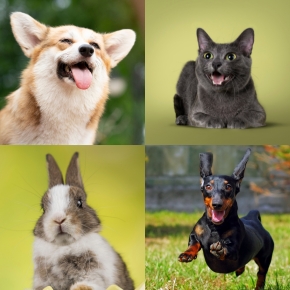
At Bayswater Vets, we’re passionate about helping pets live their best lives. While diseases like arthritis, kidney disease, periodontal disease, and ‘the Big C’ can be a concern, proactive measures can significantly reduce the risk in many cases. In this article, Vet Victoria Seale shares their 10 top tips for a healthy and happy pet.
10 tips for healthy and happy dogs, cats & rabbits
1. Regular Check-ups: Schedule bi-annual vet check-ups to monitor your pet’s health and catch any potential problems early. Victoria recommends monitoring your pet at home too – look for changes in behaviour, limping, reduced mobility, lumps, bad breath, red gums, and anything else unusual.
Call Bayswater Vets on 020 7229 2040 with any concerns.
2. Preventive Vaccinations: Stay up to date with recommended pet vaccinations for optimum protection against contagious, life-threatening diseases such as canine parvovirus, feline leukaemia, and myxomatosis in rabbits.
3. Flea, Worm and Tick Prevention: Use vet-prescribed flea, worm and tick products to protect your pet from parasites that can cause irritation as well as transmit diseases.
4. Dental Care: Brush your dog or cat’s teeth regularly with a pet-specific tooth gel and schedule professional dental cleanings as recommended by your vet. Talk to us about dental products and chew toys that can also help. Rabbits need a constant supply of fresh hay for healthy teeth and ideally 6 – 12 month dental check-ups.
5. Healthy Diet & Weight: Provide your pet with a high-quality, complete diet that meets their nutritional needs. Maintaining a healthy weight is also important for reducing the risk of obesity, early-onset arthritis, heart disease and other conditions. Bayswater Vets’ nurses can help you with pet nutrition and weight – book a nurse appointment.
6. Fresh Water: Ensure your pet has access to fresh, clean water at all times, and is drinking it. Water is vital for transporting nutrients to cells, eliminating waste, cushioning joints and organs, regulating body temperature and more. Some cats and dogs aren’t big drinkers, so Victoria suggests mixing in high-quality wet food or adding water to dry kibble.
7. Regular Exercise & Enrichment: Ensure your pet has plenty of physical exercise and mental stimulation to support their wellbeing. Here are some examples:
- Dogs: Walking, hiking, training, fetch games, interactive games & toys, agility courses (DIY or professional), swimming.
- Cats: Furry toys on string to chase, interactive games & toys, scratching posts, a catio (outdoor enclosed ‘cat patio’), a cat gym – check this one out on YouTube!
- Rabbits: An outdoor pen, digging box, foraging tray, chew toys.
Reducing excessive running and jumping can often help to delay the onset of osteoarthritis by 1) reducing stress on joints which leads to wear & tear on cartilage, and 2) reducing the risk of injuries which can contribute to the development of osteoarthritis.
8. Reduce Stress: Create a calm and comfortable environment. Stress can negatively impact your pet’s health and contribute to a range of health conditions.
9. Regular Grooming: Brush your pet’s coat regularly to keep them tangle and dirt-free, helping to prevent skin irritation and parasites. Keep nails trimmed to reduce discomfort and injuries. Avoid bathing dogs too often as this can strip their natural oils, unless there’s a specific need.
10. Avoid Toxins: Last but by no means least, Victoria stresses the importance of keeping toxic substances, including foods and plants away from your pets. Common offenders are grapes, raisins, antifreeze, fertiliser, xylitol, chocolate, and especially for cats – lilies and paracetamol. These can cause a whole host of health problems, some of which can be life-threatening.
By following Victoria’s tips, you can help your pet live a healthier, happier, and hopefully longer life. Remember, early prevention is key to maintaining your pet’s wellbeing.
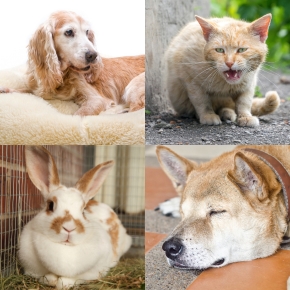
Sadly, pets can’t communicate discomfort verbally, which makes recognising and addressing pain a crucial part of their care. September is Animal Pain Awareness Month. To support this, Bayswater Vets’ Veterinary Surgeon Victoria Seale, is explaining the different types of pain, and the signs to look out for in your dog, cat, or rabbit so you can get them the treatment they need promptly.
Recognising different types of pain in pets
Vet Victoria Seale explains that acute pain is sudden and severe, typically resulting from an injury, surgery, or illness; it is often sharp and intense.
Neuropathic pain arises from damage to the nervous system and can be difficult to pinpoint – humans would probably describe it in themselves as burning or tingling.
Visceral pain is related to internal organs and is often harder to detect. It’s typically associated with conditions like gastrointestinal problems or bladder infections, some of which can be emergencies. Call us promptly on 020 7229 2040 if you spot signs of acute, neuropathic, or visceral pain in your pet.
Chronic pain is long-lasting and persists over time, often due to conditions like arthritis, dental issues, or chronic illness. Victoria recommends keeping a diary to log changes in your pet’s behaviour and demeanour, and contacting us to book a pet check-up at our practice in Bayswater as soon as possible.
Victoria shares that these are the signs of pain to look out for:
Is your dog in pain?
- Acute pain: Whining or barking more than usual, limping or favouring one leg, restlessness or difficulty settling down, avoidance of movement or play.
- Neuropathic pain: Unexplained twitching or muscle spasms, sensitivity to touch – even light pressure, difficulty walking or coordination problems, vocalisation in response to touch.
- Visceral pain: Vomiting or diarrhoea, restlessness or pacing, changes in appetite or drinking habits, abdominal tenderness or swelling.
- Chronic pain: Stiffness or difficulty getting up, reluctance to climb stairs or jump, behavioural changes such as irritability or aggression, changes in sleeping patterns or excessive sleeping.
Is your cat in pain?
- Acute pain: Hissing or growling when touched, increased hiding or withdrawal, reduced grooming or a scruffy coat, changes in eating or litter box habits.
- Neuropathic pain: Excessive grooming of a specific area, discomfort or sensitivity in certain parts of the body, unusual postures or movements, reluctance to be handled or touched.
- Visceral pain: Frequent urination or signs of straining, loss of appetite or vomiting, changes in behaviour such as hiding or aggression, abdominal swelling or sensitivity.
- Chronic pain: Decreased activity or reluctance to play, difficulty jumping onto surfaces, increased vocalisation – especially during movement, changes in litter box usage or grooming habits.
Is your rabbit in pain?
Anything that causes your rabbit to stop eating is an emergency in itself – see our emergency contact information.
- Acute pain: Rapid breathing or thumping, reluctance to move or hop, reduced appetite or refusal to eat, hiding or staying in a corner.
- Neuropathic pain: Abnormal movements or twitching, sensitivity to touch or grooming in specific areas, changes in posture or difficulty sitting normally, increased aggression or fearfulness.
- Visceral pain: Changes in droppings or gastrointestinal upset, signs of discomfort when touched around the abdomen, reduced food intake or changes in eating habits, lethargy or unusual behaviour.
- Chronic pain: Reduced activity and reluctance to hop, changes in behaviour such as aggression or timidity, difficulty grooming or poor coat condition, changes in eating habits or reduced food intake.
What to do if you suspect pain
If you notice any signs of pain in your pet, Victoria recommends contacting our vet practice in Bayswater as soon as possible. Early diagnosis and treatment can significantly improve your pet’s quality of life and address underlying conditions effectively.
Don’t hesitate to reach out to our team at Bayswater Vets, with any concerns about your pet’s health or behaviour.

Noise phobia in dogs and cats is a common but distressing condition that can significantly impact their quality of life. This anxiety disorder causes pets to become extremely fearful of loud or sudden noises, leading to intense stress and behavioural changes. Our vets in Bayswater have created this guide to help you understand noise phobia and its causes, symptoms, and treatment options to better support your furry friend.
With fireworks season just around the corner, contact the team at Bayswater Veterinary Clinic to discuss which calming products for dogs or cats may help your furry friend cope.
Understanding noise phobia in dogs and cats
What is noise phobia?
Noise phobia is an intense fear or anxiety triggered by specific sounds. Unlike a simple reaction to loud noises, noise phobia involves a heightened and persistent fear that can lead to severe behavioural issues. Common noises that might trigger this phobia include thunderstorms, fireworks, sirens, or even household appliances.
How does noise phobia present in pets?
Our vets in Bayswater share that pets with noise phobia may exhibit a range of distressing behaviours, including:
- Pacing and Restlessness: Pets may wander aimlessly or appear agitated.
- Hiding: They might seek refuge in enclosed spaces or under furniture.
- Vocalisation: Increased barking, whining, or meowing can be a sign of distress.
- Destructive Behaviour: Some pets may chew furniture or scratch walls.
- Shaking or Trembling: Physical signs of fear are common, particularly during loud noises.
These reactions can vary in severity depending on the individual pet and the intensity of the noise.
Contact us ahead of fireworks season to discuss calming aids for your pet.
Common causes of noise phobia in pets
Noise phobia can stem from a variety of causes:
- Lack of Early Socialisation: Pets who were not exposed to a range of sounds during their critical developmental period may be more susceptible to noise phobia.
- Traumatic Experiences: Past negative experiences related to loud noises, such as a frightening event during fireworks, can contribute to the development of this phobia.
- Genetics: Some pets may have a genetic predisposition to anxiety disorders, making them more prone to developing noise phobia.
- Environmental Factors: Changes in the environment, such as moving to a new home or experiencing sudden loud noises, can trigger or exacerbate the condition.
How to treat noise phobia in pets
Our team of experienced vets at Bayswater Vets have dealt with many cases of noise phobia over the years. They advise that addressing it involves a combination of strategies to help reduce anxiety and manage symptoms:
- Create a Safe Space: Designate a quiet, secure area in your home where your pet can retreat during noisy events. Provide comfortable bedding and familiar items to help them feel safe.
- Desensitisation: Gradually expose your pet to recorded sounds of the noises that trigger their phobia at a low volume, increasing the volume over time. Pair these sessions with positive reinforcement to help them associate the sounds with rewards.
- Use Calming Products: Calming aids such as anxiety wraps, pheromone diffusers, or calming treats can help alleviate anxiety. Ask our vets in Bayswater to discuss the most suitable options for your pet with you – get in touch.
- Professional Help: For severe cases, book an appointment at Bayswater Vets. The vet will examine your pet for any underlying health conditions that could be contributing to their anxiety, as well as provide a tailored treatment plan, and medication if necessary. They may also discuss behavioural therapy and enlisting the help of a veterinary behaviourist.
- Maintain Routine: Keeping a consistent routine can provide stability and comfort for your pet, helping to reduce overall anxiety.
In conclusion, noise phobia can significantly impact a pet’s wellbeing, but with the right approach, it is manageable. By understanding the causes, recognising the symptoms, and implementing effective treatment strategies, you can help your pet feel more secure and less fearful. If you have concerns about your pet’s behaviour, don’t hesitate to contact our team in Bayswater for advice.
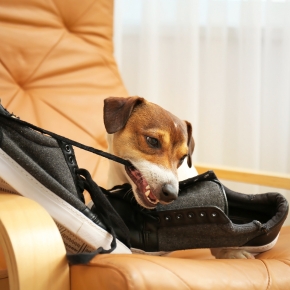
Like us, most dogs are social creatures and like it best when they are around others. This can lead to some dogs feeling anxious when left alone, even for short periods. While it’s important not to leave dogs alone for extended times, some – especially new pets and puppies – might struggle even with brief separations.
If you’re worried your dog might have separation anxiety, our Vet Victoria Seale at Bayswater Vets can offer guidance and support.
Spotting the signs of dog separation anxiety
Victoria advises that you should look out for these signs that your dog might be getting anxious:
- Pre-departure Jitters: As you get ready to head out, your dog might become restless, or start panting or pacing. They might try to follow you around or scratch at doors and carpets.
- Vocalisations: Whining, howling, or barking are common signs of distress in dogs left alone.
- Destructive Behaviour: The first 15 minutes after you leave can be the toughest for your dog. Their fear might manifest in chewing on something with your scent, seeking comfort from your presence.
- Overly Excited Greetings: When you finally return home, your dog might be super happy to see you, showering you with attention and perhaps following you around the house. They may also urinate on the spot.
Victoria also advises that a pet camera can be extremely useful in spotting the signs of an anxious dog. A camera will allow you to monitor them from just outside your front door so you can assess what’s going on, before you leave for longer.
Helping your dog feel comfortable alone
Victoria wants London dog owners to know there is good news; separation anxiety in dogs can be managed. Here are some tips from Victoria to get you started:
- Ideally Start Them Young: Gradually introduce your dog to being alone for short periods from a young age. Pick a designated area to be their comfortable space. Don’t confine them there only when they’re going to be alone, as they will then associate it with isolation. Instead, make it part of their normal routine to hang out there while you are in the house.
- Create a Safe Haven: Use a baby gate to create a space where your dog can see and hear what’s going on in the house while still feeling secure. Leave them with a tasty chew toy when you pop out for a few minutes, gradually increasing the duration of your absences.
- Normalise Comings and Goings: Avoid over-fussing your dog when you are about to leave and when you return so they don’t associate it with being left alone.
- Make it Cosy: Ensure their safe space has a comfy bed, fresh water, and some chew toys to keep them occupied. Chewing can be calming for dogs.
- Drown Out Distractions: Consider leaving a quiet radio playing to mask any outside noises that might startle your dog.
- The Power of Scent: Leaving an item of clothing with your scent on it can provide comfort for your dog while you’re away.
- Diffuse the Excitement: Let your dog outside for “toilet time” as soon as you return home, before greeting them. This can help to diffuse their initial excitement and keep any ‘accidents’ outdoors.
Need More Help?
If you would like more advice on separation anxiety tailored to your dog, our Vet, Victoria Seale, is happy to help. Don’t hesitate to contact us at Bayswater Vets.

Sunshine, longer days, and summertime adventures are here. But as temperatures rise, so does the need to adjust your pet’s care routine. Grooming is no exception. Here at Bayswater Vets, we’ve put together some tips to keep your furry friends cool and comfortable with our summer grooming strategies for dogs, cats, rabbits, and guinea pigs.
If you would like some more advice on pet grooming, or need any help with matting, nail clips and other pet care needs, our Registered Veterinary Nurses at Bayswater are here to help.
Top tips for summer grooming
Brushing up on the importance
Bayswater Vets’ nursing team advise that regular brushing is essential all year round, but it becomes especially important during the summer months. Brushing removes loose fur, which can trap heat and make your pet uncomfortable.
- Long-haired pets: Brush daily to prevent matting, which can be a real problem in hot weather.
- Medium-haired breeds: Aim for a few brushes a week.
- Short-haired companions: Weekly brushing is still beneficial.
The summer trim
For some long-haired dog breeds, a summer trim can be a great way to help them stay cool. However, it’s important not to go overboard. A double coat actually provides natural insulation, which is good for temperature regulation, so avoid shaving your dog too short. Ask our nurses or a qualified groomer for advice on the right summer style for your dog breed.
Keeping smaller pets cool
Rabbits and guinea pigs don’t typically need haircuts, but regular brushing is still important. For long-haired rabbits, consider a trim around their rear end to keep them clean and comfortable. Never attempt to shave these small pets yourself, as their skin is delicate and easily injured.
Gentle on the go
Summer often means more outdoor adventures with your pet. After walks or playtime outside, Bayswater Vets’ nursing team advise that owners should check their pet’s fur for ticks, fleas, and burrs (small, prickly seed pods or seed heads). Use a pet-safe flea comb and brush to gently remove any unwanted hitchhikers.
Top tips for all
- Hydration is Key: Ensure your pet has constant access to fresh, clean water.
- Beware the Midday Sun: Limit walks and playtime to the cooler parts of the day.
- Cooling Comforts: Provide shady areas for your pet to relax in and consider a cooling mat for them to lie on. Small furry pets may enjoy lying on a cold tile, or against a bottle of frozen water wrapped in a towel.
By following these simple summer grooming tips, you can help your dog, cat, rabbit, or guinea pig stay cool, comfortable, and looking their best all season long.
If you have any questions or concerns about your pet’s grooming needs, don’t hesitate to book a consultation with Bayswater Vets’ nursing team at Bayswater. They’re always happy to help!
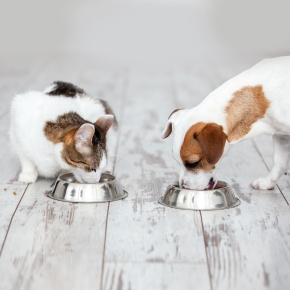
You’re not alone when it comes to having trouble choosing the best pet food for your dog or cat. With 10.5 million tonnes of pet food products sold annually across Europe and a 5.1% annual growth rate for this industry*, it’s no wonder you can feel flummoxed!
Our veterinary team at Bayswater Vets have crafted a simple guide to help pet owners in London navigate the process of pet food shopping.
Book a Tailored Nutrition Appointment
As vets, we’re often asked about the vast array of pet food choices on the market. From kitten kibble to senior support, the options can be overwhelming. Yet, there’s a straightforward explanation for this diversity: a pet’s nutritional requirements evolve throughout their lifespan. Let’s delve into why life stage matters in pet food, decipher what “complete pet food” means, and underscore the importance of consulting with a veterinary professional for maintaining your pet’s health.
Life stages of your pet
- Growing Pains: Picture a lively puppy or kitten with endless energy and a hearty appetite, fuelling their adventures and growth. Puppy and kitten food is rich in protein, calcium, and essential nutrients to support their rapid development.
- The Prime of Life: Once your pet reaches adulthood (around 1 year for cats and varying for dogs depending on breed), their growth rate slows down. Adult pet food provides the balanced nutrition they need to maintain a healthy weight, support their immune system, and keep them active.
- Golden Years: As pets age, their bodies change. Senior pet food often has lower calorie content to help prevent weight gain, while containing glucosamine and chondroitin to support joint health.
Our experienced team at Bayswater Vets can advise you on all of this – book a tailored nutrition appointment now.
What does “complete pet food” mean?
You might see the term “complete pet food” on packaging. Our vets in Bayswater advise that it signifies the food meets all your pet’s nutritional requirements for their life stage, as set by organisations like the European Pet Food Industry Federation (FEDIAF). This means you don’t need to add any supplements unless specifically recommended by your vet.
Why choose high quality pet food
Think of pet food as the foundation of your pet’s health. High-quality complete pet food, formulated for their life stage, provides the essential building blocks for a long and healthy life. It can also support digestion, skin and coat health, and even cognitive function.
Why consult your vet
While complete pet food offers a balanced base, every pet is an individual. Book a tailored nutrition appointment with one of our vets, who will consider your pet’s age, breed, activity level, and any specific health concerns to recommend the best pet food for their unique needs. They can also help with tricky transitions between life stages and advise on portion control to maintain a healthy weight.
Cats especially need a well-thought-out transition between different foods, as some changes in diet can negatively affect their health.
Our veterinary team at Bayswater Vets want pet owners in London to remember: When it comes to pet food, a one-size-fits-all approach doesn’t exist. By understanding the importance of life stage nutrition, choosing good quality complete pet food, and consulting your vet, you’re giving your pet the nutritional foundation they need to thrive at every stage of their life.
Book a Tailored Nutrition Appointment
Did you know you can buy a range of top-quality, vet-recommended complete pet foods at Bayswater Vets? Book a tailored nutrition appointment with our team to discuss your pet’s needs.
*Stats from www.europeanpetfood.org
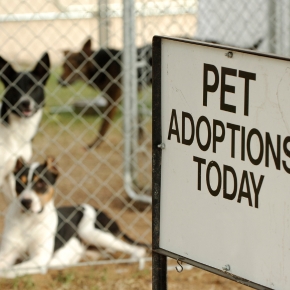
Adopting a pet can be a joyful and rewarding experience. However, vets in Bayswater advise that asking the right questions beforehand can help you make an informed decision and create a harmonious environment for your new family member. Below are some key questions to consider.
When you collect your new pet, be sure to register them with Bayswater Vets where they will receive the very best care.
Questions to ask before adopting a pet
Our vets in Bayswater have compiled these 7 important questions:
1. Why do you want to adopt a pet?
Understanding your motivation for adopting a pet is crucial. Are you looking for companionship, a playmate for another pet, or a specific breed for its characteristics? Reflecting on your reasons will help you choose the right pet that fits your lifestyle and expectations.
2. What are the pet’s needs?
Dogs, cats, rabbits, and any other type of pet have unique needs, including nutrition, exercise, housing, and veterinary care. Our vets highly recommend researching the specific needs of your desired pet type or breed to ensure you’re prepared. For example, certain dog breeds may require more exercise and mental stimulation, while some cats might have special dietary needs. If you have questions about caring for a particular pet type or breed, feel free to reach out to our team for advice on 020 7229 2040.
3. What is the pet’s history?
Understanding a pet’s background can provide insight into their behaviour and any potential challenges. Ask your local pet rescue centre in London, or further afield, about the pet’s previous living conditions, any medical history, and reasons for being up for adoption. This information will help you prepare for any behavioural issues or medical needs.
4. What are your living arrangements?
Consider your home environment and how it will accommodate a new pet. Do you have enough space for a lively dog or a secure area for a curious cat? If you rent, does your landlord allow pets? Additionally, think about any potential hazards in your home that need to be addressed before bringing your new pet home. Our vets in Bayswater vets advise that hazards might include breakables, escape routes, toxic substances and plants, and other pets.
5. What is your lifestyle like?
Your daily routine and lifestyle will significantly impact your pet’s wellbeing. Consider how much time you can dedicate to your pet for exercise, training, and socialisation. If you travel frequently or work long hours, think about how you will provide for your pet’s needs during your absence. Search for pet sitters and dog walkers in Bayswater and London to find out costs and availability.
6. Are you prepared for the long-term commitment?
Adopting a pet is a long-term commitment that can last many years. Ensure you are ready for the responsibilities of pet ownership, including the financial costs of food, supplies, and veterinary care. Consider the time and effort required to train and care for your pet throughout their life stages. We’re here if you have any questions about the long-term needs of the type of pet or breed you are considering – call us on 020 7229 2040 for advice.
7. How will you integrate the pet into your family?
If you have other pets or young children, think about how your new pet will fit into the existing family dynamic. Our vets advise that introductions should be gradual and supervised to ensure a smooth transition. Make sure to discuss with family members their roles and responsibilities in caring for the new pet.
Time to register your new pet
At Bayswater Vets, we’re here to guide you through the joy of pet adoption. Register your new pet at our vet practice in Bayswater for top-notch care and a healthy start in their new home. Our team offers advice, vaccinations, health checks, and more to keep your new pet happy and thriving.

As our beloved dogs age, their behaviour and social skills can sometimes regress. It’s not uncommon for a previously well-socialised dog to develop new anxieties or react poorly in certain situations. This is where refreshing your grown-up dog’s social skills can make a significant difference. In this article, Vet Victoria Seale explains how you can help your adult dog regain their social confidence.
Before we dive in, Victoria stresses that it’s important for London dog owners to know that some changes in behaviour can also be linked to pain and illness, especially in older dogs. A vet health check can help identify any underlying issues that might be causing or contributing to your dog’s behaviour changes. Book a check-up at Bayswater Vets before starting a re-socialisation journey with your dog.
Why refresh your dog’s socialisation skills
Victoria shares that a well-socialised dog is generally calm, confident, and comfortable in various environments and situations. They can interact peacefully with other dogs and people, displaying natural behaviours like sniffing, playing, and friendly barking. However, if a dog’s social skills deteriorate, they might become fearful or reactive, exhibiting behaviours such as cowering and trying to get away, or loud barking, growling, and even aggression.
Why a dog’s socialisation skills deteriorate over time
- Lack of Regular Practice: Over time, without consistent reinforcement, a dog’s training can slip.
- Life Stage Changes: Older dogs may develop physical issues like stiff joints, making them less eager for play and more prone to defensive behaviours – book a check-up.
- Traumatic Experiences: Negative experiences, such as being attacked by another dog, can lead to increased anxiety and fearfulness.
Try Victoria’s refresher socialisation tips for adult dogs
Before you begin, Victoria says it’s wise to remember that refreshing your dog’s socialisation skills requires patience, a structured approach, and positive reinforcement. Here are some effective strategies:
1. Refresh Basic Commands & Training: Before tackling socialisation, ensure your dog’s basic training is solid. They should respond well to commands like sit, down, stay, and walk nicely on the lead.
2. Acclimatise to New Sounds: If your dog reacts to specific sounds, such as the doorbell, hoover, thunder, or fireworks, you can desensitise them over time by playing recordings at a low volume. Reward your dog when they remain calm, gradually increasing the volume over time.
3. Experience Different Environments: Gradually reintroduce your dog to various environments. Start with calm, familiar places like a friend’s house or your local London park. Reward positive behaviour with treats and praise. Once your dog is comfortable, slowly introduce busier locations like town centres and dog-friendly shops. Garden centres can be an ideal outing for your dog to practice their socialisation skills.
4. Meet Other Dogs: If your dog used to be sociable but has started to regress, this strategy is crucial to re-master to ensure happy and safe adventures together. Introduce your dog to other dogs in a controlled setting. Begin with parallel walks, then progress to off-leash play in secure areas. Always monitor interactions closely to ensure they are positive. Victoria advises choosing a controlled environment away from home, as dogs are naturally territorial over their own space.
5. Join Dog Training Classes: Enrolling your dog in training classes can be beneficial for the both of you. These classes provide structured environments for social interaction and learning new commands, reinforcing positive behaviours.
We hope you found Victoria’s adult dog socialisation refresher tips easy to follow. If you have any queries, we’re always here to help. If you have concerns about your dog’s change in behaviour, book a health check with one of our vets before working through the guide, to find out if pain or an underlying illness could be a contributing factor.
And remember, patience, structure, and positive reinforcement are key. If you encounter challenges, don’t hesitate to consult a professional trainer for guidance.

Welcoming a new pet into your home is an exciting and rewarding experience. Whether you’re considering a dog, cat, or a smaller pet, finding the perfect companion requires careful consideration and observation. In this guide from Bayswater Veterinary Clinic, we’ll explore the positive traits to look for in a new pet to ensure a happy and harmonious relationship for years to come.
Our veterinary team in Bayswater can’t wait to meet your new bundle of joy! Register them with us and book their first appointment for unrivalled pet care from day one.
What to consider when choosing a new pet
Compatibility with your lifestyle & costs
When choosing a new pet, our Bayswater vets and nurses stress the importance of compatibility with your lifestyle. Factors such as species, size, energy levels, grooming needs, and nutrition should align with your routine for a seamless fit. Remember, pets for children often become parental responsibilities. Consider all costs, including healthcare, housing, and insurance. Plus, how would a new pet fit in with any current pets? Our team are here to discuss the care needs of different pet species before you commit – reach out.
Where to get a new pet from
From dogs, cats, rabbits, small furies and even exotic pets, there’s an abundance of loveable pets just waiting to be adopted in Bayswater and beyond. Professional rescue centres typically conduct home checks to ensure ideal pet-owner matches. Alternatively, opt for reputable breeders showcasing both mother & offspring in a caring environment and enquire about medical history and upbringing practices. Be cautious of breeders unwilling to provide necessary information – a red flag. Buying a small furry or an exotic pet from a pet shop? Check the shop’s reputation online and look for cleanliness and good practices in-store before you buy from them.
What to lookout for in a new pet
- Confidence & Sociability: A confident and sociable pet adapts well, interacts positively, and enjoys a fulfilling life. Look for curiosity, friendliness, and ease of interaction when choosing. Temperament and behaviour issues are crucial considerations.
- Good Health & Vitality: Our vets in Bayswater recommend that you assess potential pets for health & vitality. Look for clear eyes, a shiny coat, and a healthy weight. Check for signs of alertness, energy, and enthusiasm. Ask about medical history and vaccinations too.
- Healthy Parents & Genetics: Consider the health and genetics of the pet’s parents, as they significantly influence the pet’s future wellbeing. Responsible breeders provide information about lineage and health screenings, ensuring a strong foundation for the pet’s health.
- Responsiveness to Training & Handling: Observe how they respond to training and handling during interactions. Look for signs of attentiveness and eagerness to learn. A pet who responds positively to training and handling is easier to bond with, teach new skills, and integrate into your life.
Finding the perfect pet requires a thoughtful assessment of various factors, so, take your time, do your research, and trust your instincts. And, we’re here to help if you’d like more advice – just get in touch!
Register and book your pet’s first appointment with us right away.




